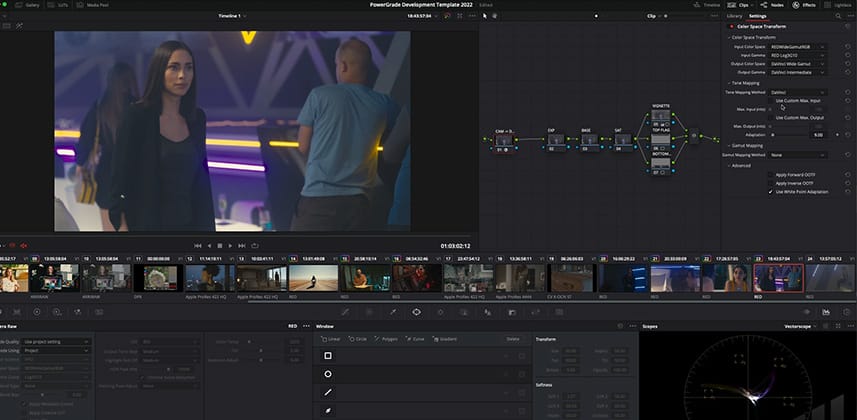How to create reusable technical Power Grades (that don’t break your images)
Have you ever been in the middle of color grading (with a client in the room) and wanted to apply a LUT that requires a technical transform for it work properly but you didn’t realize it? Or maybe you’re deep into your ‘creative brain’ as you’re color grading and forgot that the Film Look LUTs that ship with DaVinci Resolve expect a Rec. 709 Cineon Film Log gamma input – and then wonder why the LUT doesn’t look very good with you Canon Log footage?
The problem with both those scenarios is that you’re switching between two different mindsets: Creative grading and technical color management. Switching between the creative and the technical is difficult for most of us to do well. Especially if we’re on a deadline or have a client looking over our shoulders. Mistakes get made or we get unexpected results – especially if we’re on the deep end of a long day. That’s why it’s a good idea to start building and saving technical node trees as PowerGrades – ideally before you’re creatively color grading.
Building technical transforms and saving them as PowerGrades
In this Insight, I share my general process and mindset for creating reusable PowerGrade “tools” starting with:
- A walkthrough of a general project template for creating and stress testing reusable grading tools, which contains a variety of charts and footage – both synthetic and real.
- You’ll learn my best practices and the things to keep in mind when designing your tools for best results.
- Lastly, we’ll put the rubber to the road, creating a basic PowerGrade tool which sets up the built in Kodak 2383 Film Print Emulation (FPE) look-up table (LUT) for proper use with modern cinema cameras. You’ll design the PowerGrade to color grade in DaVinci Wide Gamut prior to the FPE LUT, which will impart the classic look for that print emulation.
What should you expect to learn in this Insight?
- The difference in mindset between color grading and building a reusable look or tool
- How developing “tools” (or widgets) for future use is all about speeding up your workflow while color grading
- How to create your own PowerGrade template project and adapt it to your workflow and clients
- Why simplicity is preferred over complexity when developing reusable PowerGrade tools
- How to visually evaluate images for defects
Freely downloadable test images used in this Insight
The key to my process is having a sample project that I use when I’m building re-usable PowerGrades. These samples have a wide range of looks, subject matter, and challenges that can help me evaluate the effect of my technical PowerGrades – and alert me if I’ve broken something.
Here are the available images I’ve used in this Insight (but remember, you should supplement these with typical footage you get from your clients):
Member Content
Sorry... the rest of this content is for members only. You'll need to login or Join Now to continue (we hope you do!).
Need more information about our memberships? Click to learn more.
Membership optionsMember Login


